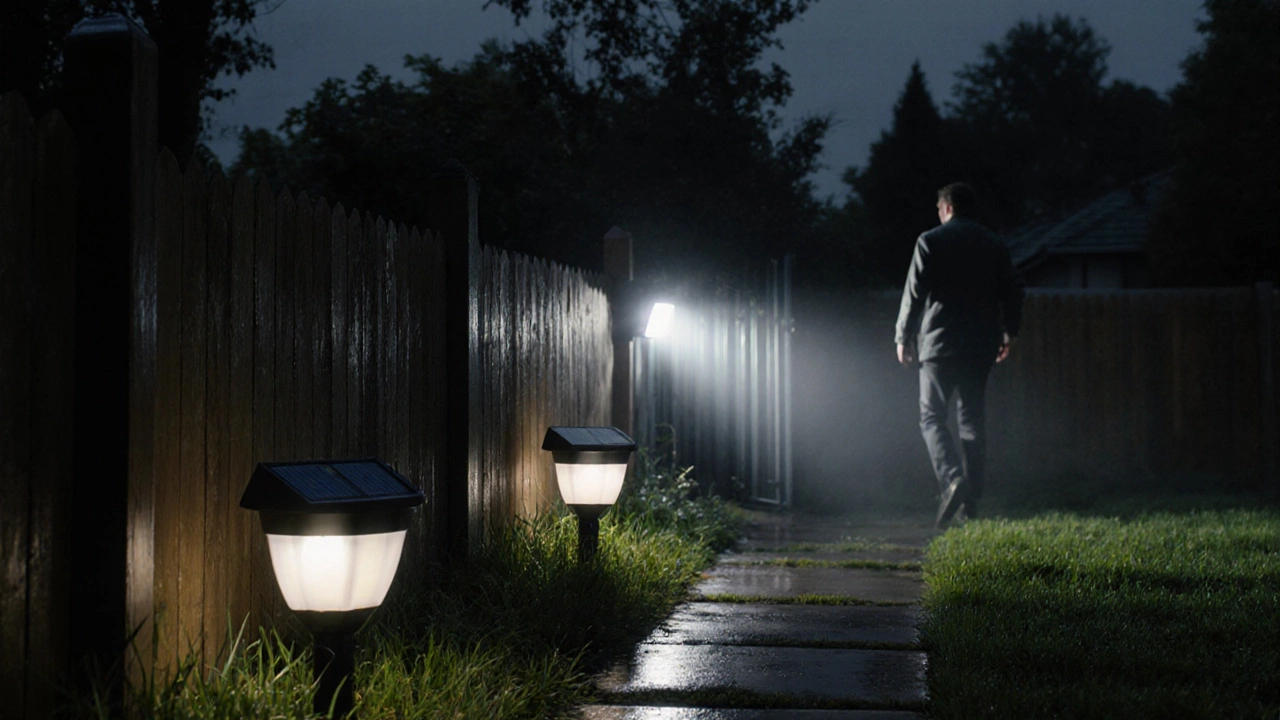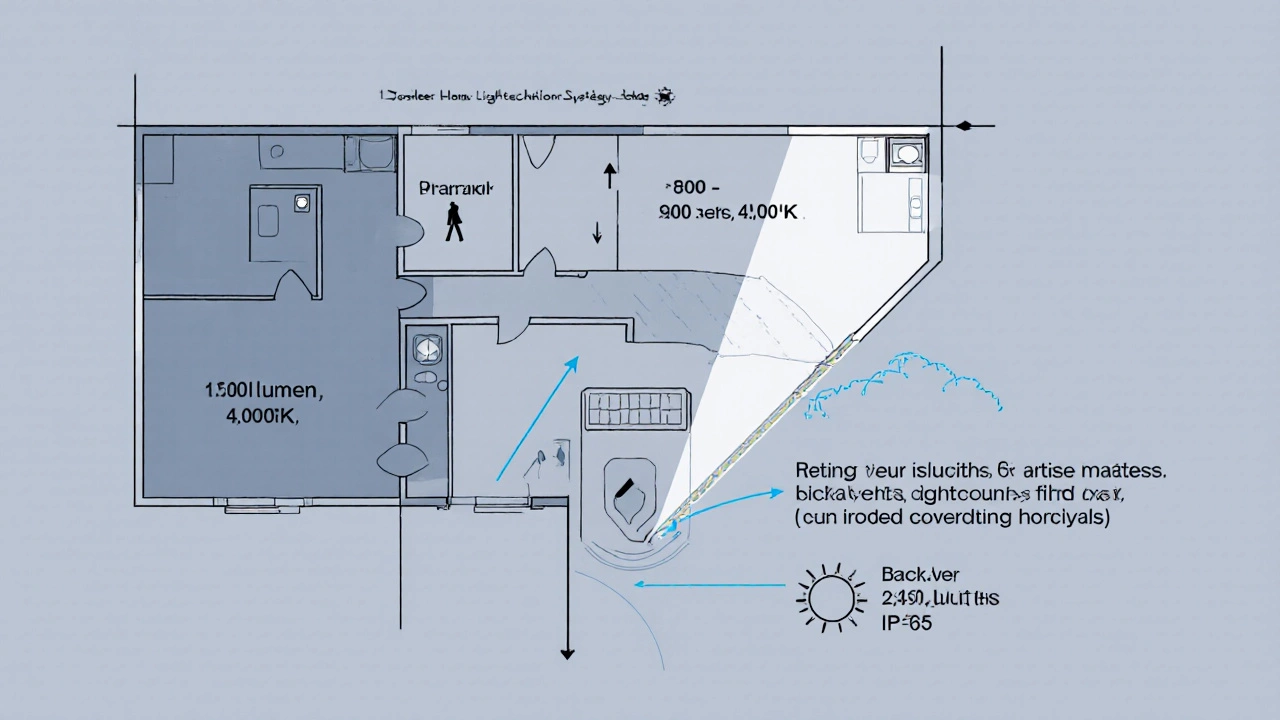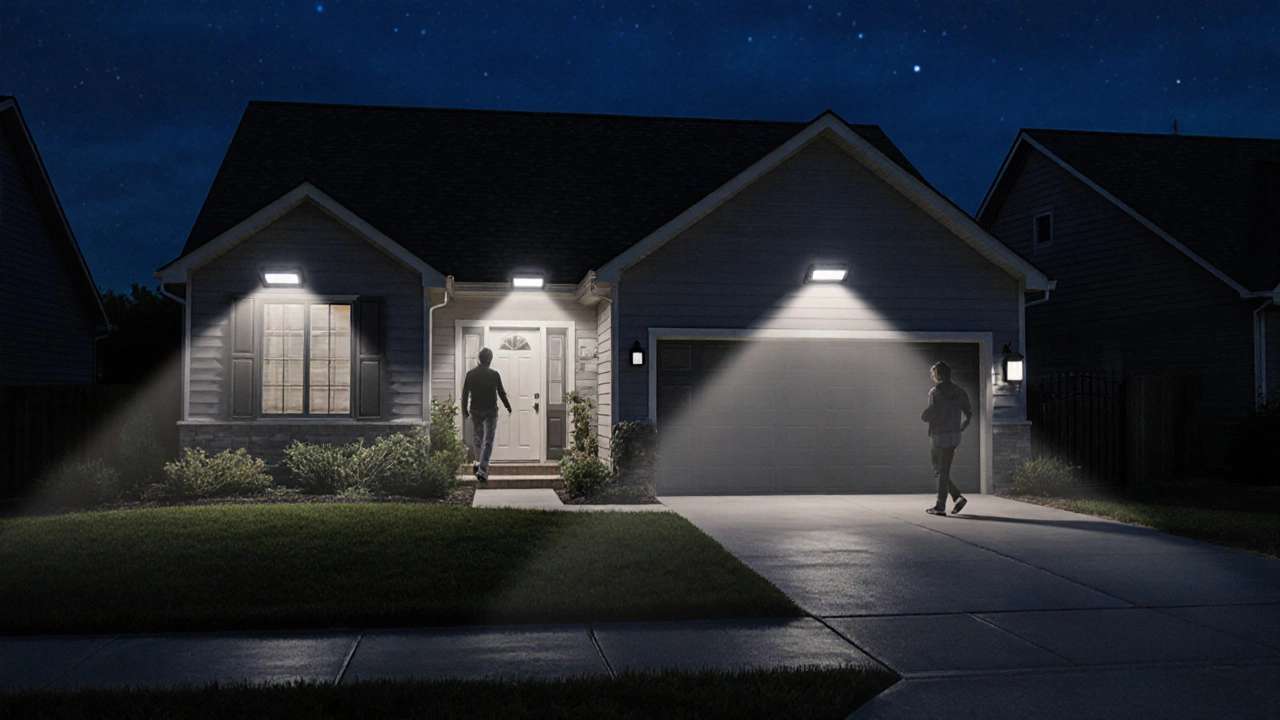Outdoor Security Lighting Calculator
Calculate Your Security Lighting Needs
When you walk outside at night and see your driveway completely dark, or your back door lost in shadow, you’re not just dealing with poor lighting-you’re inviting trouble. Criminals don’t pick homes with bright, well-lit entrances. They pick the ones where they can hide. Outdoor security lighting isn’t about making your yard look nice-it’s about making it impossible for someone to sneak around unnoticed.
Know What Kind of Light You Need
Not all outdoor lights are made the same. The first thing to figure out is what kind of light gives you real security, not just brightness. The best security lighting uses a color temperature between 3,500K and 5,500K. That’s the range of white light that makes faces, clothing, and license plates stand out clearly in the dark. Anything below 3,000K looks too yellow or orange-good for cozy patios, bad for spotting a stranger. Anything above 6,000K is too blue and harsh, causing glare that actually hides details instead of revealing them.For most homes, 4,000K is the sweet spot. It’s clean, crisp, and makes it easy to tell if someone is approaching your front door or just walking their dog. This isn’t just opinion-it’s what security professionals and police departments recommend. If you’re installing lights near your driveway or garage, go with 5,000K for maximum clarity. For pathways and garden edges, 4,000K gives enough light without washing out the natural look of your yard.
Brightness Matters-But More Isn’t Always Better
People think more lumens = better security. That’s not true. Too much light creates glare, blinds you, and casts long shadows where people can hide. The goal is even, controlled coverage-not a spotlight that turns your yard into a stage.Here’s what you actually need:
- Front door or porch: 800-1,200 lumens
- Driveway: 1,500 lumens
- Backyard or patio: 1,600-2,400 lumens (depending on size)
- Garage entrance: 1,200-1,800 lumens
- Commercial areas or large lots: 9,000-20,000 lumens
These numbers come from real-world testing by lighting engineers and security consultants. A 1,500-lumen floodlight on your driveway will light up a 12-foot radius clearly. Two of those, placed at opposite corners, will cover the whole area without dark spots. One super-bright 5,000-lumen light? It’ll blind you when you walk out and leave corners pitch black.
Choose the Right Type: Motion, Flood, or Solar?
There are three main types of outdoor security lights. Each has pros and cons.Motion-activated lights are the most popular for good reason. They turn on only when someone moves nearby. That saves energy, cuts your electricity bill, and surprises intruders. Most modern models use dual-zone sensors that can tell the difference between a cat, a car, and a person. That cuts false alarms by over half. They’re perfect for side gates, back doors, and alleyways. But if you have a lot of wildlife-possums, birds, or even swaying branches-you’ll want one with adjustable sensitivity. Otherwise, you’ll be getting a light show every time the wind blows.
Floodlights are the old-school workhorses. They stay on all night, bathing large areas in light. Great for open spaces like driveways or big backyards. But if they’re not motion-sensored, they waste energy. A floodlight left on all night can use as much power in a month as a fridge. The trick? Use them with timers or combine them with motion sensors. Some newer models have both: they dim to 10% brightness all night, then jump to full power when movement is detected.
Solar-powered lights sound perfect-no wiring, no bills. But here’s the catch: they’re unreliable in cloudy weather. In Adelaide, where we get three weeks of overcast skies in winter, budget solar lights drop to 45% brightness after six months. Premium ones (like those from LuminAID or Philips) hold 85% of their output. But they cost $60-$100 each. If you’re using them as your only security light, you’re taking a risk. Use solar lights as supplemental lighting-on side paths, garden edges, or where running wires is impossible.
Installation Height and Placement Are Everything
You can have the best light in the world, but if it’s mounted wrong, it’s useless. The number one mistake people make? Mounting lights too low or pointing them straight up.Mount your lights between 6 and 10 feet high. That’s out of reach for most vandals and gives you the best downward angle. Point them down, not up. Upward lighting creates glare and hides faces. Downward lighting reveals them.
Focus on entry points: front and back doors, garage doors, basement windows, and side gates. Don’t just light up your front yard-light the path to your back door. Intruders don’t come through the front. They come from the side or back, where they think no one’s watching.
Use overlapping coverage. If you have a fence line, put lights on both sides. If you have a long driveway, place lights at the start, middle, and end. Shadows are your enemy. A single light leaves dark pockets. Two or three lights, spaced properly, eliminate them.

Weatherproofing and Durability
Australia gets rain, humidity, and salt air-especially near the coast. Your lights need to survive it. Look for an IP65 or IP67 rating.IP65 means the light is sealed against dust and water jets from any direction. That’s enough for most homes. IP67 means it can handle being briefly submerged-useful if you live in a flood-prone area or near a pool.
Check the housing material. Aluminum or polycarbonate is best. Cheap plastic cracks in the sun. Steel rusts. Look for UV-resistant coatings. If the product doesn’t say what it’s made of, avoid it. You don’t want a $30 light that dies after one summer storm.
Smart Features and Compatibility
You don’t need a smart home to use smart lighting-but if you have one, make sure your lights play nice. In 2025, 63% of new security lights connect to Wi-Fi. That means you can turn them on from your phone, set schedules, or get alerts when motion is detected.But here’s the catch: 35% of security lighting failures happen because people buy a fancy smart light and it doesn’t work with their existing system. If you use Google Home, Amazon Alexa, or Apple HomeKit, check compatibility before you buy. Philips Hue, Lepro, and Feit Electric all have clear compatibility lists. Don’t guess.
Some newer models even use AI to tell the difference between a person and a dog. Lepro’s 2023 dual-zone sensors cut false alarms by 58%. Philips Hue’s 2023 update lets lights turn on automatically when your phone leaves work and turns off when you arrive home. That’s not magic-it’s smart integration.
Energy Efficiency and Cost
LED lights use 75% less energy than old incandescent bulbs. That’s not marketing-it’s fact. ENERGY STAR certified lights meet strict efficiency standards and last up to 25,000 hours. That’s over 20 years of normal use.Hardwired systems cost $150-$300 per fixture to install professionally. Battery-powered lights need new batteries every 6-12 months-about $15-$25 per year. Solar lights cost more upfront but save on electricity. The real savings come from motion sensors. A light that’s on 24/7 uses 80% more energy than one that only turns on when needed.
Don’t buy the cheapest option. Amazon reviews show that budget solar lights under $25 lose half their brightness in a year. Premium models cost more, but they last. Think long-term. A $70 light that lasts 10 years is cheaper than three $25 lights that die every 2 years.

What to Avoid
Here’s what most people get wrong:- Using warm white (3000K) for security-too yellow, hides details
- Mounting lights too high or pointing them upward-creates glare
- Buying non-weatherproof lights-rain kills them fast
- Using only one light in a large area-leaves blind spots
- Ignoring compatibility with smart systems-leads to frustration
- Choosing solar lights as your only option in cloudy areas-unreliable
Also avoid lights without adjustable sensors. If your light turns on every time a bird flies by, you’ll turn it off-and then you’re back to square one.
Real Results: What Works
One homeowner in Adelaide installed four 4,000K, 1,500-lumen motion-activated floodlights at 8 feet high-front door, back door, garage, and side gate. They used shielded fixtures to cut glare. Within three months, their nighttime break-in attempts dropped by 90%. No alarms. No cameras. Just light.Another family replaced their old 60-watt bulbs with LED motion lights. Their electricity bill dropped $18 a month. They didn’t even notice the lights were on-until someone tried to climb their fence. The light flashed on. They saw the face. Called the cops. Got the guy.
It’s not about having the fanciest system. It’s about having the right light, in the right place, at the right time.
Should I use solar outdoor security lights?
Solar lights are great for supplemental lighting, like garden paths or side yards, but not reliable as your main security system in areas with frequent cloud cover-like Adelaide in winter. Budget solar lights lose up to 60% of their brightness after a year. Premium models hold 85-90%, but cost $60-$100 each. Use them where wiring is impossible, but pair them with hardwired or battery-powered lights for critical areas like doors and driveways.
What color temperature is best for security lighting?
For security, choose 4,000K to 5,000K. That’s neutral to cool white light that makes faces, clothes, and license plates stand out clearly in the dark. Avoid warm white (3,000K) for security areas-it’s too yellow and hides details. Anything above 6,000K is too blue and causes glare, making it harder to see.
How many lumens do I need for my driveway?
For a standard residential driveway, aim for 1,500 lumens. That’s enough to clearly illuminate a 12-foot radius. Use two lights placed at opposite ends for full coverage. One powerful light creates shadows and glare; two balanced lights eliminate dark spots and make it easier to spot movement.
Do motion sensors cause false alarms?
Yes, but only if you pick the wrong model. Older sensors trigger from animals, wind, or passing cars. Newer models use dual-zone detection and AI to distinguish between humans, pets, and vehicles. Look for lights with adjustable sensitivity settings. That way, you can dial down the sensitivity if you live near a busy road or have lots of wildlife.
Is it worth hiring an electrician to install outdoor lights?
If you’re installing hardwired lights, yes. Professional installation costs $150-$300 per fixture but ensures safety, code compliance, and proper wiring. DIY is fine for battery-powered or solar lights, but if you’re tapping into your home’s electrical system, a licensed electrician avoids fire risks and insurance issues. Plus, they’ll know where to place lights for maximum coverage.
What’s the difference between IP65 and IP67 ratings?
IP65 means the light is sealed against dust and water jets from any direction-perfect for most outdoor use. IP67 means it can handle being submerged in water up to 1 meter deep for 30 minutes. Choose IP65 for standard installations. Go for IP67 if you live near the coast, have a pool, or get heavy flooding. Both are better than no rating at all.
Next Steps
Start by mapping your property. Mark every entry point: doors, windows, gates, garage. Then, sketch where lights should go-aim for overlapping coverage, 6-10 feet high, pointing down. Pick 4,000K-5,000K LED lights with motion sensors and IP65 rating. Check compatibility with your smart home if you have one. Buy two or three premium lights first. Test them. See how they work at night. Then expand. You don’t need to light your whole yard. Just the places where someone might try to get in.Security lighting isn’t about being flashy. It’s about being smart. The right light in the right place doesn’t just scare off intruders-it gives you peace of mind. And that’s worth more than any discount sale.

